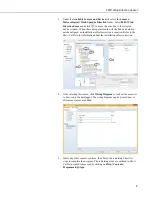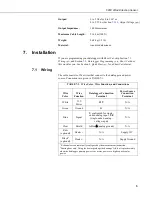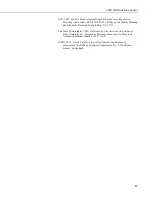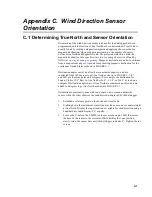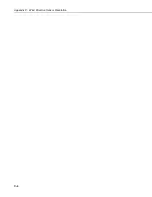
C-1
Appendix C. Wind Direction Sensor
Orientation
C.1 Determining True North and Sensor Orientation
Orientation of the wind direction sensor is done after the datalogger has been
programmed, and the location of true North has been determined. True North is
usually found by reading a magnetic compass and applying the correction for
magnetic declination; where magnetic declination is the number of degrees
between true North and Magnetic North. The preferred method to obtain the
magnetic declination for a specific site is to use a computer service offered by
NOAA at
. Magnetic declination can also be obtained
from a map or local airport. A general map showing magnetic declination for the
contiguous United States is shown in FIGURE
Declination angles east of true North are considered negative, and are
subtracted from 360 degrees to get true North as shown in FIGURE
and 360° are the same point on a compass). For example, the declination for
Logan, Utah is 13.5° East, so true North is 360° – 13.5°, or 346.5° as read on a
compass. Declination angles west of true North are considered positive, and are
added to 0 degrees to get true North as shown in FIGURE
Orientation is most easily done with two people, one to aim and adjust the
sensor, while the other observes the wind direction displayed by the datalogger.
1.
Establish a reference point on the horizon for true North.
2.
Sighting down the instrument center line, aim the nose cone or counterweight
at true North. Display the input location or variable for wind direction using a
hand-held keyboard display, PC, or palm.
3.
Loosen the U-bolt on the CM220 (or the set screws on pn 1049) that secure
the base of the sensor to the crossarm. While holding the vane position,
slowly rotate the sensor base until the datalogger indicates 0°. Tighten the set
screws.
Summary of Contents for 020C
Page 2: ......
Page 6: ......
Page 20: ...020C Wind Direction Sensor 12 ...
Page 22: ......
Page 24: ......
Page 28: ...Appendix C Wind Direction Sensor Orientation C 4 ...
Page 29: ......

